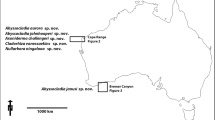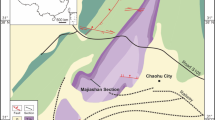Abstract
EXTREMELY food-poor environments, such as the deep sea, place extraordinary demands on organisms with respect to feeding, resulting in modifications of the feeding strategies found in shallow waters. A general rule is that macrophagy becomes a better strategy than microphagous suspension-feeding1–3. The characteristics by which phyla are defined, nonetheless, remain unchanged in these adaptations. We present here an apparently unique example of a fundamentally different body plan, derived from a pre-existing phylum, occurring in deep-sea sponges. We demonstrate that the Cladorhizidae have evolved carnivory and capture small crustaceans by means of filaments provided with raised hook-shaped spicules. This adaptation to a food-poor deep-sea environment has resulted in the loss of the diagnostic characteristics of the phylum Porifera: an aquiferous system and choanocytes.
This is a preview of subscription content, access via your institution
Access options
Subscribe to this journal
Receive 51 print issues and online access
$199.00 per year
only $3.90 per issue
Buy this article
- Purchase on SpringerLink
- Instant access to full article PDF
Prices may be subject to local taxes which are calculated during checkout
Similar content being viewed by others
References
Deep-sea Biology (eds Gage, J. D. & Tyler, P. A.) (Cambridge Univ. Press, Cambridge, 1991).
Monniot, C. Ambio Spec. Rep. 6, 73–74 (1979).
Monniot, C. & Monniot, F. C. r. Acad. Sci. Paris, III 312, 383–388 (1991).
Bergquist, P. R. in The Origins and Relationships of Lower Invertebrates, The Systematics Association edn Vol. 28 (eds Morris, S. C. et al.) 14–27 (Clarendon, Oxford, 1985).
Lévi, C. in Biology of the Porifera, Symp. zool. Soc. London edn Vol. 25 (ed. Fry, W. G.) 353–364 (Academic, London, 1970).
Invertebrate Relationships. Patterns in Animal Evolution (Willmer, P.) (Cambridge Univ. Press, Cambridge, 1990).
Reiswig, H. M. J. exp. mar. Biol. Ecol. 14, 231–249 (1974).
Reiswig, H. M. Biol. Bull. 141, 568–591 (1971).
Boury-Esnault, N., Harmelin, J. G. & Vacelet, J. La Recherche 24, 848–851 (1993).
Vacelet, J., Boury-Esnault, N. & Harmelin, J. G. Deep-sea Res. 41, 965–973 (1994).
Koltun, V. M. (in Russian) Inst. Oceanol. Acad. Sci. U.S.S.R. 86, 165–221 (1970).
Wilkinson, C. R. & Garrone, R. in Nutrition in the Lower Metazoa (eds Smith, D. C. & Tiffon, Y.) 157–161 (Pergamon, Oxford, New York, 1980).
On Some Remarkable Forms of Animal Life from the Great Deeps off the Norwegian Coast (Sars, G. O.) (BrÝgger & Christie, Christiana, 1872).
Ridley, S. & Dendy, A. Rep. Scient. Res. Challenger, Zool. 20, 275 (1887).
Lundbeck, W. Danish Ingolf-Exp. 6, 1–219 (1905).
Tendal, O. S., Barthel, D. & Tabachnik, K. Deep-sea Newsl. 21, 11–12 (1993).
Childress, J. J. et al. Science 233, 1306–1308 (1986).
Cavanaugh, C. M. et al. Nature 325, 346–348 (1987).
Schmaljohann, R. & Flügel, H. J. Sarsia 72, 91–98 (1987).
Bergquist, P. R. Sponges (Hutchinson, London, 1978).
Author information
Authors and Affiliations
Rights and permissions
About this article
Cite this article
Vacelet, J., Boury-Esnault, N. Carnivorous sponges. Nature 373, 333–335 (1995). https://doi.org/10.1038/373333a0
Received:
Accepted:
Issue Date:
DOI: https://doi.org/10.1038/373333a0



